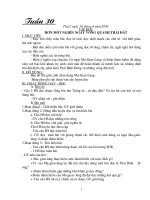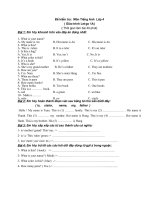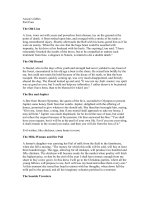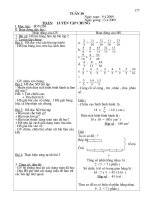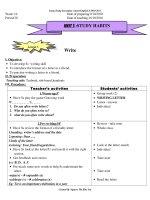English 4- week 30
Bạn đang xem bản rút gọn của tài liệu. Xem và tải ngay bản đầy đủ của tài liệu tại đây (113.91 KB, 10 trang )
<span class='text_page_counter'>(1)</span><div class='page_container' data-page=1>
Week 30 Period 115
Date of planning: 14/4/1017
<b>UNIT 17: HOW MUCH IS THE T- SHIRT?</b>
<b>Lesson 2: 4-5-6</b>
<b> I. AIMS. </b>
By the end of this lesson, Ps will be able to listen and write about price of clothes.
1. Knowledge:
Sentence patterns: revision
Vocabulary: revision
<b>2. Skills: speaking, listening and reading</b>
3. Attitude: Ps know about prices
II. TEACHING METHODS:
- Work in pairs , individual, in groups ….
III. TEACHING AIDS:
<i>1. Teacher’s: student’s and teacher’s book, pictures, cassette.</i>
<i>2. Students’: books, notebooks, workbooks.</i>
<i>3. Class organization:</i>
Class Date of teaching Absent pupils
4A
4B
17/4/1017
17/4/1017
………
………
IV. PROCEDURE:
Teacher’s activities Pupils’ activities
<b>I. Warm up:(5’)</b>
Spend a few minutes revising the previous lesson Ask
some pupils to go to the front of the class to ask and
answer about the prices of clothes.
Work in pairs.
<b>II. New lesson:(30’)</b>
<b>4. Listen and write the prices.(10’)</b>
a. Pre-listening:
- Ask ps to look at the books and sets the scene
<i><b> How many pictures are there?What’s this?</b></i>
<b>- Ask Ps to look at the pictures on page 49</b>
- Tel Ps that they are going to listen four dialogues
and write the prices.
- Focus their attention on the incomplete sentences so
that they can understand how the language is used.
Help them to identify who the characters. Check
understanding.
b. While-listening:
- Play the recording for ss to circle the correct
answers.
- Play the recording again for them to check their
Look at the pictures
Ps answer the T’s
questions.
</div>
<span class='text_page_counter'>(2)</span><div class='page_container' data-page=2>
answers.
- Get Ps to swap their answers before you check as a
class.
<b>Key: a. 90,000dong b. 73,000 dong</b>
c. 80,000 dong d. 95,000 dong
c. Post listening:
- Play the game: Lucky numbers.
<b>5. Look and write ( 10’)</b>
<b>a. Pre- writing:</b>
<b>- Ask ss to look at the pictures on page.</b>
<i>How many numbers are there? What are they?How</i>
<i>much are they?</i>
- Tell Ps that they are going to write the name of each
clothing item and its price.
- Give them a few seconds to look at the pictures,
sentences and read the text. Remind the pupils that we
use than when making comparisons. Then they wask
them to read the questions and write the answers. If
necessary, get pupils to work in pairs.
b. While- writing:
- Set a time limit for the task and offer help, if
necessary.
- Check the answers as a class and call one or two ps
to read aloud the completed text.
<b>Key:</b>
2. brown sandals, seventy two thousand dong.
3. the pair of blue jeans is eighty –eight thousand
dong
4. the pair of black and write shoes is eighty thousand
dong.
<b>c. Post reading:</b>
- Ask Ps to play a game: Whisper
<b>3. Let’s sing: (10’) </b>
- Tell Ps that they are going sing the song Buying
clothes.teach the song, following the procedure in
Teaching the unit components in Introduction.
- Ask them to read the line of the lyrics aloud.Check
understanding.
- Play the recording all the way through. Ask ss to do
choral and individual repetition of the song line by
line until they get familiarized with the pronunciation,
the stress, the rhythm and the tune of the song.
- Play the recording again and get Ps to sing along
Ps swap.
Play the game.
Look at the pictures.
Listen to the teacher.
Identify the what someone
is doing.
Ps do the task.
Swap their answers.
Play the game.
Listen.
Ps work in groups of three.
</div>
<span class='text_page_counter'>(3)</span><div class='page_container' data-page=3>
with the recording.
- Divide the class into two groups, one sings the
questions and the other sing the answers .
<b>III. Consolidation:(3’)</b>
? What’s the content of the lesson? T- Ps
<b>IV. Home-link: (2’)</b>
- Do exercises in the workbook. Learn by heart the
new words and structures.
Individually
* Comments:
………
………
……….
Week 30 Period 116
Date of planning: 14/4/1017
<b>UNIT 17: HOW MUCH IS THE T- SHIRT?</b>
<b>Lesson 3: 1-2-3</b>
<b> I. AIMS. </b>
By the end of this lesson, Ps will be able to pronounce two syllable words with the
stress on the first syllable
1. Knowledge:
Sentence patterns: revision
Vocabulary: revision
<b>2. Skills: speaking, listening and reading</b>
3. Attitude: Ps know about pronounce two syllable words with the stress on the first
syllable
II. TEACHING METHODS:
- Work in pairs , individual, in groups ….
III. TEACHING AIDS:
<i>1. Teacher’s: student’s and teacher’s book, pictures, cassette.</i>
<i>2. Students’: books, notebooks, workbooks.</i>
<i>3. Class organization:</i>
Class Date of teaching Absent pupils
4A
4B
17/4/1017
17/4/1017
………
………
IV. PROCEDURE:
Teacher’s activities Pupils’ activities
<b>I. Warm up:(5’)</b>
Spending a few minutes revising the previous
lesson .Whole class sing the song:Buying clothes.
Sing the song.
<b>II. New lesson:(30’)</b>
</div>
<span class='text_page_counter'>(4)</span><div class='page_container' data-page=4>
- Tell Ps that they are going to pronounce the
following words: sandals, trousers, jumper, jacket.
- First, explain to pupils what a syllable is.Then put
the four taget words on the board, using vertical lines
to divide the syllables.
- Play the recording and ask Ps to repeat a few time.
Then put the words on the board, play the recording
and ask Ps to repeat a few more times. After that,
write the sentences on the board.
- Play the recording a few more times and let Ps say
the sentences , paying attention to the target sounds.
- Do choral and individual repetition of the sounds,
words and sentences until Ps feel confident.
- Get some Ps to perform in front of the class. Check
as a class and correct the pronunciation, if necessary.
<b>2. Look at the sentences and the stress marks. </b>
<b>Then listen and say the sentences aloud. (10’)</b>
a. Pre-listening:
<i><b> How many sentences?</b></i>
- Tell Ps that they are going to listen to the recording,
repeat the sentences.
- Give them a few seconds to read the sentences in
silience and guess the words to fill in the gaps.
- Have P listen to the recording and circle the
appropriate options . Allow them time to do the task
independently. If necessary, have Ps listen to the
recording more than once.
b. While- listening.
- Give them time to write the words in the gaps
independently .
- Get Ps to swap their answers before you check as a
class. Monitor the activity and offer help if necessary.
- Ask Ps to say the sentences aloud.
<b>Audio:</b>
1. How much is this jacket?
2. The yellow jumper is very nice.
3. How much are these brown trousers?
4.The scandals are one hundred thousand dong.
c. Post-listenning.
- Get Ps to play the game: Slap the board
<b>3. Let’s chant (10’)</b>
- Tell Ps that they are going to say the chant. Follow
the procedure in Teaching the unit components in
Listen.
Look the words.
Listen and repeat in
chorus, individually.
Do in choral- individual
Ps perform in front of the
class.
Answer T’s questions.
Listen.
Listen and number.
Ps swap.
Say the sentences aloud.
Play the game.
</div>
<span class='text_page_counter'>(5)</span><div class='page_container' data-page=5>
Introduction.
- Have them read the chant and check comprehension.
- Play the recording more than once, if necessary, for
Ps to do choral and individual repetition until they get
familiarized with the pronunciation, the stress, the
rhythm and the intonation of the chant. Show Ps how
to chant and do actions.
- Divide the class into groups of four and call two
groups to give a demonstration: one group chants the
questions, the other chants the anwers.
- Get groups to sit opposite of each other and practise
chanting and doing acting. Go around offering help, if
necessary.
- Call three groups to front of the class to chant and
do actions. The rest of the class claps along to the
<b>rhythm </b>
Read the chant.
Do choral and individual
repetition.
Work ito groups of four.
Some of groups sing the
chant and do actions.
<b>III. Consolidation:(3’)</b>
? What’s the content of the lesson? T- Ps
<b>IV. Home-link: (2’)</b>
- Do exercises in the workbook. Learn by heart the
new words and structures.
Individually
* Comments:
………
………
……….
Week 30 Period 117
Date of planning: 14/4/1017
<b>UNIT 17: HOW MUCH IS THE T- SHIRT?</b>
<b>Lesson 3: 4-5-6</b>
<b>I. AIMS. </b>
By the end of this lesson, Ps will be able to understand what a stress in words.
1. Knowledge:
Sentence patterns: revision
Vocabulary: revision
<b>2. Skills: speaking, listening and reading</b>
3. Attitude: Ps know about stress in words
II. TEACHING METHODS:
- Work in pairs , individual, in groups ….
III. TEACHING AIDS:
</div>
<span class='text_page_counter'>(6)</span><div class='page_container' data-page=6>
<i>3. Class organization:</i>
Class Date of teaching Absent pupils
4A
4B
19/4/1017
21/4/1017
………
………
IV. PROCEDURE:
Teacher’s activities Pupils’ activities
<b>I. Warm up:(5’)</b>
Spending a few minutes revising the previous lesson:
Say the words and ask pupils How many syllables are
there in the word? What’s stress?
Ps answer.
<b>II. New lesson:(30’)</b>
<b>4. Read and complete. (10’)</b>
a. Pre- reading.
- Ask Ps to look at the text and pictures , ask some
questions
<i>What’s this? What does this paragraph talk about?</i>
- Tell Ps that they are going to read the text and
complete the table.
- Aks Ps to read questions first. Then read the email
and focus on the information needed to answer the
questions.
b. While-reading.
- Ask Ps to read the text and find appropriate
information to complete the sentences. Ask Ps to
work in pairs or small groups.
- Give them time to do the task independently.
- Get Ps to swap their answers before checking as a
class. If there is enough time, let some pairs ask and
answer the questions.
<b>Key: </b>
At school At home
On hot days A blouse, a short
skirt, a red scarf and a
pair of sandals
A blouse, a pair of
shorts and a pair
of slippers
On cold days A jacket over a
jumper, a long skirt, a
red scarf and a pair of
socks and shoes
A jumper, a pairs
of trousers, a pair
of socks and
slippers
c. Post- reading.
- Play the game: Whishper
<b>5. Draw three clothing items and write their </b>
<b>prices. (10’)</b>
a. Pre- writing
- Ask Ps to answer T’s questions.
Answer theT’s questions.
Listen to the teacher.
Work in pairs .
Do the task.
Ps swap.
</div>
<span class='text_page_counter'>(7)</span><div class='page_container' data-page=7>
<i><b> What’s this? What are you going to draw? What ar </b></i>
<i>you going to write?</i>
- Tell Ps that they are going to draw your three
favourite clothing items and write their prices.
- Ask Ps to work in pairs or groups to discuss what
are they going to draw.
- Focus ps on their given clues. Check
comprehension.
b. While-writing.
- Give ps time to do the task independently.
- Get Ps to swap their answers before checking as a
class.
- If there is time, Ask one Ps to present on the board.
c. Post writing.
- Call some Ps to read aloud / display their writing
<b>6. Project.(10’)</b>
- Tell Ps that they are going to make four flashcards
of clothes.Explain the activity and check
understanding.
- Give each of them a card.Ask them to copy the table
from the Pupil’s book onto their cards.
- Tell Ss that they are going to do a project.
- Ask them to write the information about themselves.
Encourage them to complete their tasks. Get them to
swap their task in pairs. They should look at their
parters tasks and describe each other.
- Call some pupils to the front of the class and tell the
class about their tasks. To make this activity more
challenging, you may ask them not to look at the
<b>answers. </b>
Answer the T’s questions.
Listen to the teacher.
Work in pairs or groups to
discuss.
Do the task.
Swap their answers.
Read / Display.
Listen to the teacher.
A pair do a demonstration.
Ps tell the class about their
tasks.
<b>III. Consolidation:(3’)</b>
? What’s the content of the lesson? T- Ps
<b>IV. Home-link: (2’)</b>
- Do exercises in the workbook. Learn by heart the
new words and structures.
Individually
* Comments:
</div>
<span class='text_page_counter'>(8)</span><div class='page_container' data-page=8>
Week 30 Period 118
Date of planning: 14/4/1017
<b>UNIT 18: WHAT’S YOUR PHONE NUMBER?</b>
<b>Lesson 1: 1-2</b>
<b>I. AIMS. </b>
By the end of this lesson, Ps will be able to Use the words and phrases related to the
topics phone numbers and Outdoor activities. Ask and answer questions about
phone numbers, using What’s…..’s phone number? It’s….
1. Knowledge:
Sentence patterns: What’s…..’s phone number? It’s….
Vocabulary: review
<b>2. Skills: speaking, listening and reading</b>
3. Attitude: Ps know how to talk the phone numbers
II. TEACHING METHODS:
- Work in pairs , individual, in groups ….
III. TEACHING AIDS:
<i>1. Teacher’s: student’s and teacher’s book, pictures, cassette.</i>
<i>2. Students’: books, notebooks, workbooks.</i>
<i>3. Class organization:</i>
Class Date of teaching Absent pupils
4A
4B
19/4/1017
21/4/1017
………
………
IV. PROCEDURE:
Teacher’s activities Pupils’ activities
<b>I. Warm up:(5’)</b>
Prepare pupils for this unit by revising numbers from
zero to nine. Write the numbers randomly on the
board. Point at each of them and have pupils say the
number. Point at a quicker pace to make it more
challenging.
Ps say the words.
<b>II. New lesson:(30’)</b>
<b>1. Look, listen and repeat.</b>
- T tell ps that they are going to read a story in which
the characters ask and answer questions about phone
numbers, using What’s…..’s phone number? It’s……
<b>- Have them look at the pictures to discuss the context</b>
in which the language is used. Ask them questions
<i>such as: Who are they? ? Where are they?What are</i>
<i>they talking about?(Nam and Linda are at school. In</i>
<i>picture a, b and c, they are talking about Linda’s new</i>
<i>mobie phone. In picture d, Nam ask Linda for her</i>
<i>phone number, using What’s your phone number?</i>
<i>And Linda answers It’s 0912158657) Check</i>
Listen to the teacher.
Look at the pictures and
identify characters
</div>
<span class='text_page_counter'>(9)</span><div class='page_container' data-page=9>
understanding.
- Play the recording so they can listen and repeat. Do
choral and individually repetition, pointing to the
characters speaking.
<b>- Play the recording again for Ps to listen and repeat.</b>
<b>2. Point and say.</b>
a. Vocabulary:
- Review the phone numbers
+ Checking: Slap the board.
- T guides Ss how to play
b. Model sentences:
<i>A:What’s your phone number? </i>
<i>B: It’s 098 207 4511</i>
- Concept check: intonation, using
c. Practice:
<b>- Tell Ps that they are going to practise asking and</b>
answering questions about phone numbers, using
What’s…’s phone number? It’s…...
- Have them look at the phone numbers in the pictures
and the names under them. Point to picture a and have
them say the phone number. Do choral and individual
repetition. Then tell the class to work in pairs and
practise asking and answering questions about phone
numbers, using the text in the bubbles and the picture
cues.
- Call a few pairs to act out the dialogue in front of
the class. Check as a class or correct pronounciation,
if necessary.
Language note: We usually say a phone number in
singer digits: one-one- five(115) When 0 is in a phone
number, it is pronounced oh ( eg: 0904355600=
oh-nine-oh-four,three-five-five, six-oh-oh)
<b>Work in pairs. Ask your partners’ phone</b>
<b>numbers.</b>
- Tell ps that they are going to ask their parners’
phone numbers in pairs, using What’s ….’s phone
number? It’s…
- Ask ps to write their own phone number on a piece
of paper.
- Have them work in pairs, one asking and the other
giving the answer.
- Call on a few pairs to ask out the dialogue in front
of the class. Correct the pronounciation, is necessary.
chorus- individual
Listen and repeat in
chorus- individual.
Listen and do the steps.
Listen and point
T – W – C
H – H
O – P -> C – P
Look at 4 pictures and
work in pairs
Role play and speak out.
Ps do choral and
individual
Ps work in pairs.
Listen.
Ps work in pair
</div>
<span class='text_page_counter'>(10)</span><div class='page_container' data-page=10>
<b>III. Consolidation:(3’)</b>
? What’s the content of the lesson? T- Ps
<b>IV. Home-link: (2’)</b>
- Do exercises in the workbook. Learn by heart the
new words and structures.
Individually
* Comments:
………
………
……….
</div>
<!--links-->

